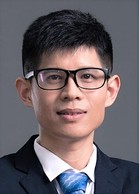
Prof. Baozhuang Niu South China University of Technology | Biography: Professor Niu is a Second Class Professor and Xinghua Distinguished Scholar at South China University of Technology. He is a recipient of the National Outstanding Youth Science Foundation and Senior Editor of the UTD journal Production and Operations Management. He is mainly engaged in cross-border logistics supply chain management, competitive and cooperative game optimisation, intelligent financial technology, etc. He is now presiding over the "Supply Chain Resilience and Security Fundamental Theory" National Natural Science Foundation of China (NSFC), and 14 research results have been published in top international journals such as MSOM, POM, TRB, etc. He was awarded the "Outstanding Achievements in Scientific Research of Chinese Universities" by the Ministry of Education of China (MEC). He has won more than 10 national and provincial awards, including the Second Prize of Outstanding Achievements in Scientific Research of Chinese Universities (Humanities and Social Sciences), China Youth Award in Management, and the First Prize of Outstanding Achievements in Philosophy and Social Sciences of Guangdong Province. Selected as one of Elsevier China's Highly Cited Scholars, China's Highly Contributing Scholars and Stanford's Top 2% Scientists in the World list. Approved the Model Course for Postgraduate Students in Guangdong Province and the Model Course for Course Civics and Politics "Supply Chain Finance". Topic: Channel Conflicts, Coordination, and Resilience in Cross-border E-commerce |
Assoc. Prof. Zhenzhen Zhang STongji University | Biography: Zhenzhen Zhang is an Associate Professor and Ph.D. supervisor at the School of Economics and Management, Tongji University. He has been selected into Shanghai's High-level Talent Program. He has long been devoted to the theoretical research and algorithm design of large-scale integer programming and uncertain optimization, as well as their applications in logistics and transportation planning and intelligent manufacturing. He has published over 20 papers in SCI/SSCI journals, including Operations Research, INFORMS Journal on Computing, Transportation Science, and Transportation Research Part B, etc. He is a recipient of the Excellent Young Scientists Fund from NSFC, andhe has led talent projects from Shanghai, as well as research initiatives from Huawei and COSCO Shipping. He is also a core member of the innovative research group project titled “Operation Management of Comprehensive Transportation Systems.” He serves as the Executive Secretary of the Transportation branch of the Society of Management Science and Engineering of China, a member of the Technical Committee on Optimization of Freight Transportation and Logistics Systems of the World Transportation Convention, and as a director of the Stochastic Service and Operations Management Branch of the Operations Research Society of China. He is also a long-term reviewer for over 30 international journals, including Operations Research and Transportation Science. Topic: Path Planning in Uncertain Environment |
Chenyang Xu IEEE Fellow PVmed | Biography: Chenyang Xu, Co-Founder, President and Co-Chairman ofPVmed, is an IEEE Fellow, a member of the IEEE Fellow Selection Committee of the IEEE Biomedical Engineering Society, a member of the Advisory Board of the Department of Biomedical Engineering at Johns Hopkins University, a member of the Advisory Board of the Department of Electrical Engineering and Computer Science at UC Berkeley, and a member of the General Editorial Board Advisory Board of the IEEE The Institute of Biomedical Engineering. Advisory Board of the Department of Electrical Engineering and Computer Science at UC Berkeley, and Advisory Board of IEEE The Institute. Dr Xu Chenyang was the General Manager and CTO of Siemens North America Innovation Center (Silicon Valley), co-founder and Director of Interventional Imaging R&D Office at Siemens Research Institute of America (Princeton), and co-founding Director of Siemens China Medical Imaging Validation and Application Center (Beijing). He is known as the founder of the fundamental theory of Gradient Vector Flow (GVF) for computer vision. This theory is one of the important computer vision theories, and its first paper has more than 6,000 citations and is included in university textbooks around the world and international authoritative computer vision reference guides. To date, Dr Xu Chenyang has published more than 80 international papers with more than 26,000 citations. Topic: Intelligent Cancer Treatment: The Integration of AI Medical Technology and Global Innovation Ecosystems |
Yang Hui General Manager of Education Industry, Tencent Cloud | Biography: Hui Yang is the General Manager of Tencent Cloud Education Industry, responsible for strategic planning and customer experience innovation in education field. He joined Tencent in 2007, and has been responsible for the R&D of many products, such as QQ membership and Pai Pai, etc. Since 2018, he has been responsible for the R&D of Tencent Cloud products for the education industry, with main products serving more than 120,000 schools, 300,000 educational enterprises, and over 1,000 provincial and municipal education authorities. With the rise of AI-generated content (AIGC), Yang Hui leads the team to accelerate the exploration of the deep integration of AIGC and the education industry, and promotes the breakthrough of innovative scenarios in colleges and universities, education enterprises, and basic education to help the education industry realize digital transformation and intelligent upgrade. Topic: Tencent's Applications and Exploration of AI in Supporting Educational Instruction |



